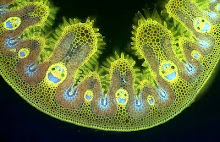Passion flowers Passiflora spp. are amongst the most elaborate of all flowers but I particularly like the relative simplicity of this diminutive species, Passiflora citrina which hails from the hills of western Honduras and eastern Guatemala. Its mountain origins mean that it does well in a cool conservatory. The flowers are only a few centimetres long and the whole plant will happily grow in a large pot on a windowsill, trained up slender canes, where it will flower for months on end.
The structure of Passiflora blooms is unusual, with the ovary and stamens held aloft from the centre of the flower on a long column. It has been suggested that this arrangement evolved to avoid damage from visiting pollinators (usually bees, although large red-flowered species are visited by hummingbirds) that probe for nectar at the base of the petals. Keeping the ovary - all important for seed production - out of harm's way will making sure that the visiting pollinator contacts those stamens and stigmas on the way in and out is a win-win strategy from the plant's perspective. The flowers are protandrous, meaning that the anthers shed their pollen first and then, once it has all been removed by pollinators, those three nail-shaped stigmas on top of the ovary move outwards and become receptive, so promoting cross pollination.
Passion flowers are loaded with religious symbolism, with the number of floral parts being taken by the faithful to symbolised various episodes in the life of Christ. For example, the ring of floral filaments is considered to represent the crown of thorns, the three stamens represent the nails used in the crucifixion and the five stamens represent the five wounds - usually with this species Passiflora caerulea being the 'typical' symbolic passion flower.
The edible passion flower P.edulis, like the one above, is easy to grow from the dimpled seeds in commercial passion fruits, although the flowers are quite small and lack the boldness and symmetry of P.caerulea. I've found that the best way to germinate these seeds, and those of many other tropical and subtropical plants like lychees, is to clean the seeds then put them in a polythene bag of moist peat (or a substitute like coir) and keep them in the airing cupboard near the hot water tank - remembering to check regularly for germination.

















